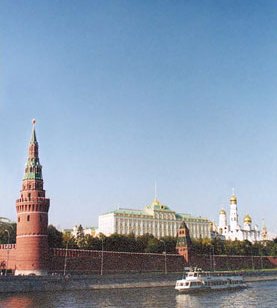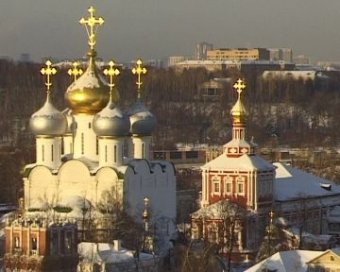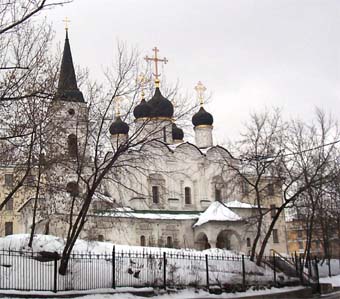|
|
| |
RUSSIA
MOSCOW
Nowadays Moscow is the capital of the biggest country in the world, with a territory of 17.5 mln. square kilometres stretching from West to East, from the Baltic Sea to the Pacific Ocean for 9 500 kilometres. It is surrounded by three oceans'1 seas. Population wise Moscow is one of the biggest cities in the world.
 Kremlin
Since long ago Moscow has been considered the outstanding cultural center of Russia. Many things concerning the cultural life of Russia occured first in Moscow. The first significant Russian libraries opened in Moscow in the XV-th century (in boyar houses, the Tsar's palaces, cathedrals and monasteries). The first public library and reading hall, which was free of charge, opened in the XVIII-th century. For the first time in Russia there was a theatre performance, in Moscow, in 1672. There are over 140 theatres and theatre groups in Moscow. Among them over 70 professional theaters famous nationwide and 2 professional circuses.
THEATRES
The Bolshoy theatre (The State Academic Theatre Of Opera And Ballet). The History of the theatre starts from 1776. Presently this theatre is one of the biggest centers of Russian music culture. Its glory is due to its famous singers and dancers.
The Maly theatre is one of the oldest in Russia - it was opened in 1824.
The Moscow Art Academy theatre was formed in 1898 by K. S. Stanislavsky and V. I. Nemirovitch-Danchenko. This theatre developed great plays, which became part of world theatre history, such as "Chaika" ("Sea gull"), "The Three Sisters", "Vishnevy Sad" ("Cherry Gar-den") by A. P. Chekhov, "Tsar Fedor Ioannovitch" by A. K. Tolstoy, "Na Dne" ("At the Bottom") by A. M. Gorky and many other plays.
The Moscow Conservatory named after P. I Chaikovsky It was founded by N. G. Rubinstein. The conservatory was opened in 1866.
The Moscow Circus on Tsvetnoy Boulevard was founded in 1880 by an entrepreneur A. I. Salamonsky. In the 1980-s the old building was demolished and a new building specialized for the circus was built.
The Big Moscow circus on Vernadsky prospect. The circus building of the circus was built in 1971. The building, the diameter of which is 100 m, can fit 3 300 people. The most interesting features of the building are its multiple stages (with changing intervals of 1.5 to 3 minutes), such as its universal stage, its stage for illusionists, its stage for water performances, its ice coated stage and many others. This circus is among the biggest stationary style circuses in the world.
MUSEUMS AND ART GALLERIES
There are over a hundred state museums, approximately 300 community museums in Moscow, besides several private museums being formed in the capital. Russia s treasures are concentrated in 80 main museums and their affiliates, most of which are situated in the centre of Moscow. Besides museums, objects of art are exhibited in over a hundred halls and art galleries.
Oruzheynaya Palata has existed since 1508, in the XVI - XVIII-th centuries it managed production, purchase and storage of weapons, items for the palace and jewelry. In the XVIII-th century icon production and an art shop were attached to it. The palace became a treasury for objects of exceptional historical and artistic value. Items, stored in the museum, are objects of palace life, weapons, jewelry, and objects of Russian, West European, and Eastern art made before the XX-th century.
The Diamond Fund of the Russian Federation (located in The Kremlin, Oruzheynaya Palata building) is the largest collection of unique jewelry and precious stones from the XVI - XlX-th centuries in Russia. Here symbols of the reign of the Tsars are stored. Among other items in the museum there are diamonds, such as the "Orlov" (189.62 carats), the "Sheikh" (88.7 carats), and the largest diamondin the world cut in a sapphire shape (258.8 carats). The largest remaining native gold nugget in the world the "Big Triangle" (36 kilograms), unique jewelry, and medals and rewards of the highest art value are also kept on display.
 Novodevichy Monastery
The State Historical Museum was founded in 1872. Its exhibits tell us about different stages of history and important events in Russia from ancient times until the present day. There are over 5 million items and over 50 thousand archives
The State Tretyakov Gallery is the largest museum in the world of the Russian fine art. Industrialist P. M. Tretyakov started his private collection of drawings by Russian artists in 1856. In 1892 he presented his collection to the city of Moscow. His gift consisted of 1287 paintings, 518 sketches and 9 sculptures. Since that time the possessions of the Gallery have greatly increased. The Especially interesting items in the gallery are the unique and most valuable collections of Russian icons and paintings by Russian artists of the XlX-th century.
The main exposition represents over 50 thousand items of Russian art and approximately the same number of items is in reserve storage. The gallery exhibits the best paintings made by famous Russian artists, such as V. L. Borovikovsky, K. P. Brullov, V. A. Tropinin, P. A. Fedotov, A. A. Ivanov, V. G. Perov, I. N. Kramskoy, V. E. Makovsky, A. M. and V. M. Vasnetsov, A. K. Savrasov, V D. Polenov, I. E. Repin, V. I. Surikov, V. V. Vereschagin, N. K. Rerikh, I. I. Levitan, V. A. Serov, A. N. Benua, M. A. Vrubel, K. S. Malevich, M. Z. Shagal, M. S. Saryan and other artists, and also sculpture work by M. M. Antokolsky, S. T. Konenkov and other masters.
The Moscow Art Museum named after A. S. Pushkin is in Russia second only to the Hermitage in Saint Petersburg in its rich collection of foreign art from ancient times till the XX-th century. The museum was opened in 1912 and was called "Museum of Fine Arts". The museum exhibits copies of the most famous European paintings and sculptures, unique cultural and historic objects of Egyptian, Assyrian, Ancient Greek and Roman art, and also originals of western European art (mainly paintings from Dutch, French and Italian art schools), as well as antique vases, coins and other objects of historic and cultural value.
The Collection of the museum contains original drawings by H.V.R. Rembrandt, P. P. Rubens, A. van Dake, C. Monet, P. Picasso, O. Renoir, V. van Gogh, P. Gogen, P. Sesann, A. Matisse and others. The museum has one of the best and the world s largest collections of French impressionism and postimpressionism. The museum regularly has thematic exhibitions of foreign art.
The theater museum named after A. A. Bakhrushin is the largest theatre museum in the world. A. A. Bakhrushin founded it in 1894 and in 1913 he presented his collection, which consisted of over 12 thousand exhibits, to the Russian Academy of Science. The museum is situated in A. A. Bakhrushin's house and in a building next to it, which A. A. Bakhrushin purchased for his exhibition.
In 1919 A. A. Bakhrushin received the status of life long director of the museum, which was named after him. Presently the collection of the museum consists of over 1.5 million exhibits on the history of drama and music theater from the XVIII-th century until the present.
 The central museum of Ancient Russian culture and art named after Andrey Rublev is situated in the buildings of the former Andronikov monastery, which was founded in the XlV-th century. The museum itself was founded in 1947, and since 1960 it has been open to the public.
The exhibits of the museum contain a unique collection of Russian icons of the XIII-XX-th centuries, including icons by Andrey Rublev, Dionisy, Feofan Greek and other famous Russian icon artists, and also a collection of Russian frescos of the XI-XVII-th centuries. The interior of one of the most ancient buildings in Moscow - the white stone Spas Nerukotvorny Cathedral (1420-1427) contains the remaining fragments of frescos, painted under the spiritual guidace of Andrey Rublev and Daneel Cherny.
SHOPPING IN MOSCOW
A shopping tour of Moscow boutiques is a pleasure for lovers of exclusive clothing. Boutiques in the capital offer a wide range of products by world famous designers. Here one can buy clothing, footwear and accessories, as well as jewellery and cosmetics of the most well-known companies. You will find clothing to suit any taste, besides that there are exquisite gifts, original souvenirs and nice items for the home on display.
The well-known houses of fashion (Givenchy, Max Mara, Nina Ricci, Bally) own boutiques in the Petrovsky Passage (Petrovka street, 10). This department store built in the "modern" style between 1905-1906 (architect S. Kalugin) has recently been restored and is now one of the most prestigious shopping malls in Moscow. Two-tiered shopping rows connect the Petrovka and Neglinnaya streets with glittering, magnificent shopping halls, whose insides are designed to be harmonius with the architectural style of the building.
For Muscovites and guests of the capital the Actor Gallery means first of all the Mercury boutique, as its windows on Tverskaya street attract everybody's attention and invite one into the world of faultless time and eternal beauty.
Kuznetsky most street was famous for its shops in the XIX century. A character from Griboedov's "Woe from Wisdom" refers to Kuznetsky most and its eternal French fashion influence with regret. Now mainly Italian fashion boutiques are to be found here. Valentine boutique (Kuznetsky most, 20) covering 500 square metres is the largest one in Europe covering 500 square metres.
Gianfranco Ferre is another renowned Italian designer whose boutique happens to be next to Valentino, at Kuznetsky most 19. Here one can find Ferre s latest collection as well as his first line. The same building is shared by Gianni Versace. This luxurious Moscow boutique is to be found in all the catalogues of the Versace group. Koty (Kuznetsky most, 18) next to the Versace boutique offers the latest pret-a-porter collections by famous Italians: Ferre, Versace, Doice & Gabbana.
We continue our tour about Moscow's boutiques in Stoleshnikov pereulok. Clothes from Cerruti 1881 (16/18, Stoleshnikov per.) have an everyday stylishness to them. The corner of Stoleshnikov pereulok and Petrovka street is the location of a new Christian Dior boutique. This shop became the third one in the world designed in accordance with Dior's new concept. The first one is in Paris in Avenue Montaigne, the second one is in Tokyo.
Thierry Mugler boutique (Stoleshnikov per., 14) demonstrates the first line of his collection.
In Stoleshnikov pereulok there is a specialized shop for the younger generation with the funny name "Baza 14". Here young people buy Chevignon clothes, genuine American Levi's, chat in the Internet cafe and choose excellent CDs in the music section.
On your way from Stoleshnikov pereulok to Bolshaya Nikitskaya it is worth making a stop at the corner of Tverskaya and Mokhovaya streets next to the National hotel building. There, at the end of 1997 S.T. Dupont opened a boutique, which became his first one in Eastern Europe.
Walking past the Moscow Conservatoria, up Bolshaya Nikitskaya street it is worth visiting the Yves Saint Laurent boutique at N 24. His first line of pret-a-porter de luxe is on sale here. This is classical wear for serious respectable ladies.
One of the oldest French fashion houses Guy Laroche opened its boutique nearby, at 24/1 Bolshaya Nikitskaya.
And now let us stroll along the most unusual street of Moscow - St. George street. Though it is not to be found on any map of Moscow, it is familiar to those who appreciate the impeccable quality of things and their elegant style. It is easy to find: the street is inside one of the most fashionable Moscow hotels the Radisson Slavyanskaya (2, Berezhkovskaya nab.). St. George street is roofed in and is the hotel's richest decoration.
All along St. George street there are numerous boutiques with collections from world famous designers.
Kutuzovsky prospect is one of the grandest and most picturesque in the capital. Tourists never miss it, attracted by the Arch of Triumph and the memorial complex on Poklonnaya Hill. It has recently become on of Moscow s fashionable shopping streets, as famous as New York's Fifth avenue.
As you drive from downtown Moscow to the Arch of Triumph look at the left side of the prospect. Block N 19 in green and gold colours will attract your attention. This is Valentin Youdashkin Fashion House.
"Moskva Shopping Center" (31, Kutuzovsky prospect) boasts of the finest showcases in Kutuzovsky prospect. It is a Mecca of exclusive items. The most pretentious client will be satisfied upon hearing the world famous names found here.
Donna Karan boutique housed at N 23, Kutuzovsky prospect offers the best samples of clothing created by this distinguished American couturier.
The Russian capital, famous for its underground palaces (the Moscow metro is one of them) acquired one more gorgeous underground structure. It is Shopping Complex Okhotny Ryad (Manezh-nayapl., 1) covering a large area from the Moskva hotel to the Manege exhibition centre. This new underground kingdom of comfort and style possesses all you need for your home and yourself.
The most famous Moscow department store of Moscow, GUM (Red Square, 3), is situated nearby. Constructed in 1895 by architect A. Pomerantsev and decorated by O. Bovet, this trade complex, called the Upper Trading Rows, housed over 200 small shops before 1917. The name of GUM (Russian acronym for State Department Store) was given to it in 1921. The length of all its counters is over 2,5 km - three times as long as Tverskoy boulevard. The German Escada boutique in GUM gives a choice of clothing of one and the same hue of color. The diversity of shades is impressive. One more larger and finer boutique Escada is at 26, Tverskaya street. If you are an admirer of this brand you will find everything from footwear to perfume here.
Well-known perfumery brands have their own boutiques in GUM. One can't miss the magnificent showcase of the Estee Lauder boutique. This American company demonstrates dozens of cosmetics and perfumery products. You will be offered a small gift if you make a purchase. Specially trained consultants using computers determine the skintype of the customer, choose the right skin cream, powder, lipstick and eyeshadows, and provide consultations. All these services are free of charge. On the customer's request his name is entered in the store s files for regular information about the newest products on sale.
A visit to GUM is worth the effort, though it takes you the whole day to see every stand, every boutique.
This is the store where you can buy absolutely everything you need for a comfortable life.
Find new business partners in Russia with the help of Bozhur.com - the Guide to trade and investments in Central and Eastern Europe
|
|
|
Holidays & Events
New Year's Day, January 1
The last week in December is quite festive, culminating with New Year's Eve. Presents are given on New Year's Day.
Russian Orthodox Christmas,
January 7
A new official holiday celebrates Russian Orthodox Christmas.
(The Orthodox Church still follows the old calendar, which differs from the Gregorian by 13 days.) Churches throughout the country hold services.
Women's Day, March 8
Established after the Second International Conference of Socialist Women in Copenhagen in 1910, women receive gills and usually do not have to work'. Even though socialism is out, celebrating women is still in!
Easter or Pashka, March/April
Traditional Russian Orthodox holiday
May Day, May 1
Even though no longer celebrated as International Workers' Solidarity Day, this event, now known as Labor and Spring Holiday, retains the festive nature, with colorful parades through Moscow's Red Square and St Petersburg's Palace Square.
Victory Day, May 9
Parades are held at war memorials such as the Piskaryovskoye Cemetery in St Petersburg to celebrate V-E Day at the end of World War II in Europe.
Maslenitsa, or Blini Day, 1st week in March
This day stems from the Pagan tradition of making blini pancakes to honor the coming of spring; blini represent the sun.
Each spring, there are festivals in the major cities and towns to celebrate the end of winter.
Navy Day, July
In St Petersburg, the fleet, including ships, submarines and sailors, is displayed about the city.
White Nights Festival, June 21 to July 11
While the sun hardly sets, many musical concerts, theatrical performances, street events, fireworks and other celebrations take place throughout Moscow, St Petersburg and the Golden Ring area.
Siege of Leningrad Day, September 8
This day marks the end of the 900-day seige of former Leningrad and includes special ceremonies at the Piskarovskoye Cemetery.
Moscow Day, Sept 19
A day for merry-making in the city.
Anniversary of the October Revolution,
November 7
A traditional holiday for nearly 75 years to commemorate the Anniversary of the October Revolution
(on the old calendar, the revolution took place on Oct 25). No longer a state holiday, many Russians continue to celebrate not having to celebrate the 1917 Revolution anymore!
Russian Winter Festival,
December 25-January 5
Events are held to celebrate the coming new year, especially in Moscow, St Petersburg, Novgorod, Vladimir and Suzdal, where troika rides, along with other traditional Russian folk customs, take place. Because the Soviet Union ceased to exist on December 21, 1991, Christmas week now offers another reason to celebrate a new beginning.
|